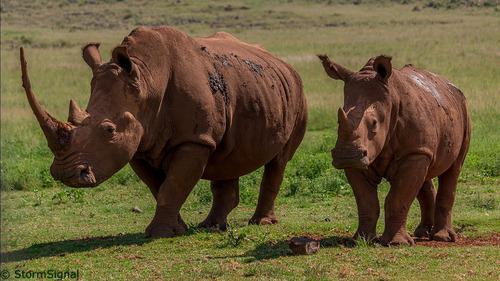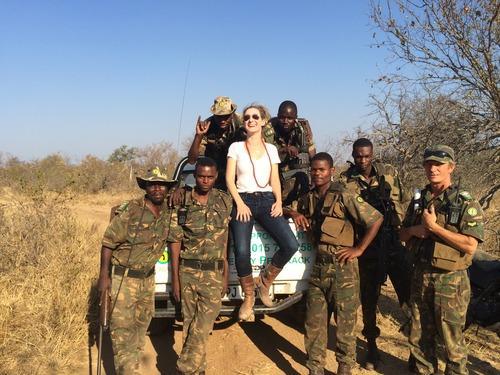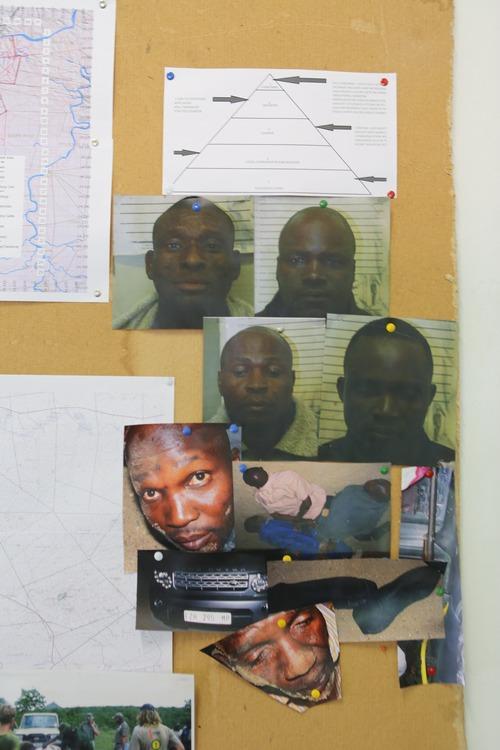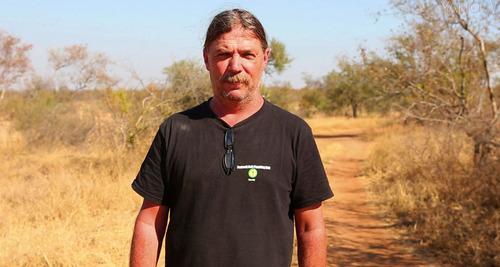When most travelers head to Africa for a safari vacation they are hoping to spot the “Big Five.” That is shorthand for the big game— lion, elephant, buffalo, leopard and rhino. But, if things don’t change and soon, they will only ever get a chance to see the “Big Four.”
To date, there are only 26,000 rhinos left in Africa — 80 percent of which are in South Africa, mostly in Kruger National Park. Last year, 1,004 rhinos were killed in South Africa. So far this year, the number has climbed to 618, with the toll in Kruger at 400.
Since 1992, Vincent Barkas has been on the front lines of what he calls the “Rhino Genocide” in South Africa. His small unit of just over 100 men patrol the area just south of Kruger in Hoedspruit, South Africa, searching for rhino poachers.
In the small area that Barkas patrols there are 2,000 rhino — 126 of which were slaughtered in the first six months of this year.
 Keep your hands off our horns. (Photo: Storm Signal.)
Keep your hands off our horns. (Photo: Storm Signal.)
The rhino’s horn, which is biologically similar to our toe nails, is believed to cure everything from cancer to impotence in countries like China and Vietnam. And now that those countries are experiencing an economic boom, the demand has climbed even higher.
“It’s just gotten out of hand,” Barkas told me. “There’s no incentive not to poach. The money is so good.”
He noted noting the price of rhino horn is now up to $9,000 per gram. Meanwhile, Barkas’ men live in sparse conditions. They work in pairs and spend up to 30 days and nights patrolling the bush — sleeping in tents barricaded with thorn bush gates.
Adding to the difficulty of their job is the fact that they face fully armed men and aren’t allowed to shoot their guns – they don’t even have money for handcuffs. When they catch someone, their shoelaces have to suffice to bind their hands.
Poachers aren’t the only threat. In 2011 and 2013, two of Barkas’s men were killed by lions. “The biggest killer in the bush is complacency,” Barkas sighed. For all this hardship, he is paid a mere $300 a month.

Rolling with the underpaid, heroic crew of the Protrack Anti-Poaching Unit. (Photo: Andrew Rothschild)
They have tried to deter poachers by posting signs that the horns have been poisoned. It makes no difference. They try cutting the horns themselves to spare the rhinos death by poaching.
“We have to leave 8 inches above the snout and they will kill for those 8 inches,” Barkas said sadly.
The poachers aren’t who you would expect. In the last year, Barkas and his teams have caught businessmen, veterinarians and even schoolteachers, trying to make an extra buck off the endangered animals.

Some of the poachers caught in the weeks before we got there. They paid a $300 bond for illegal weapons and were out on the street the next day. (Photo: Paula Froelich)
“The woman we arrested last week drove a brand new Land Rover and had a huge house,” Barkas said. “The rhino horns have created a false economy. People make money, buy new houses and cars — but then need more money to keep them.”
Barkas himself looks like he would fit right in somewhere in Kentucky (Ed Note: my family is from Kentucky. I love Kentuckians).

This is the face of the man trying to save the rhinos from extinction. (Photo: Paula Froelich)
His face is leathery and weather-worn. He wears a camo trucker hat that says ” SHUT UP + FISH” on it. A Jack Daniels lighter sits on his desk amid empty cans of red bull. He smokes non-stop. The walls of his office are plastered with a macabre collage of photographs: rhinos with their faces blown off, undergoing autopsies, and pictures of poachers they’ve caught.

The group discovers a fallen rhino. (Photo: Andrew Rothschild)
The poaching became a serious epidemic in the nineties.
“Everyone warned us the rhino killings would start,” Barkas said. “But we didn’t act until it was almost too late. It’s the demand from Vietnam and China. You used to be able to legally kill the rhinos for trophies with a license. So the rhinos were killed, and just their horns were glued to a piece of wood and sent out of the country to the East as ‘trophies.’ So the demand for the horn started up again.”
“This is not a Rhino War,” Barkas says, “it’s a rhino genocide. We can’t play by their rules – they have none. We have to only work certain hours, our staff needs time off. The poachers don’t take time off. They will kill them any time of the day or night. The poachers are winning the physical and economic battle.”
As I drove around with Barkas and his team, I saw a lot of wildlife… but no rhinos. The only rhinos I did see were at a roadside eatery set on 10 acres, which had three for viewing. And although their horns had been lopped off, they were still behind electric fences, monitored by cameras, wearing radio collars and watched over by several armed guards.
Related: These Are the Safaris You Need to Do Now
“Even those three rhino are under threat, because look — they still have some horn left,” said our driver Theo. “Someone will probably get them this year. It’s inevitable.”
By Barkas’s estimation, the rhino in South Africa will be gone within the next two years unless something drastic is done. Now.
Want to get involved or train with the team? The Rhino Protrack team takes volunteers, donations and applications on its website or Facebook page.

A beautiful and saddening story but also one of hope. I have traveled to South Africa a couple of times for long periods and it is the animals that are the draw. Any extinction would be a great loss but the rhino, like the elephant and lion, are symbols of the continent itself. Admiration to those on the frontline of helping with this cause.
Pingback: Paula Forelich launches new Yahoo! Travel program | Lawlor Media Group
Pingback: The Best Vacation Ever? Cuddling Orphaned Baby Rhinos | Slantpoint Democrat
Pingback: The Best Vacation Ever? Cuddling Orphaned Baby Rhinos
Pingback: The Best Vacation Ever? Cuddling Orphaned Baby Rhinos | Interesting News
Pingback: Hotel And Flight Info | Your Ultimate Travel Search Experience